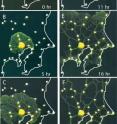Slime design mimics Tokyo's rail system
What could human engineers possibly learn from the lowly slime mold? Reliable, cost-efficient network construction, apparently: a recent experiment suggests that Physarum polycephalum, a gelatinous fungus-like mold, might actually lead the way to improved technological systems, such as more robust computer and mobile communication networks. This revelation comes after a team of Japanese and British researchers observed that the slime mold connected itself to scattered food sources in a design that was nearly identical to Tokyo's rail system.
The related report will be published by the journal Science on Friday, 22 January. Science is the journal of AAAS, the nonprofit science society.
Atsushi Tero from Hokkaido University in Japan, along with colleagues elsewhere in Japan and the United Kingdom, placed oat flakes on a wet surface in locations that corresponded to the cities surrounding Tokyo, and allowed the Physarum polycephalum mold to grow outwards from the center. They watched the slime mold self-organize, spread out, and form a network that was comparable in efficiency, reliability, and cost to the real-world infrastructure of Tokyo's train network.
"Some organisms grow in the form of an interconnected network as part of their normal foraging strategy to discover and exploit new resources," Tero writes in the report. "Physarum is a large, single-celled amoeboid organism that forages for patchily distributed food sources... [It] can find the shortest path through a maze or connect different arrays of food sources in an efficient manner with low total length yet short average minimum distance between pairs of food sources, with a high degree of fault tolerance to accidental disconnection."
The researchers knew that capturing the essence of this biological system in simple rules could be useful to inform the construction of self-organizing and cost-efficient networks in the real world. They captured the core mechanisms needed by the slime mold to connect its food sources in an efficient manner and incorporated them into a mathematical model.
Since the slime mold has been subjected to countless rounds of evolutionary selection, this formula based on its feeding habits might provide a route to more efficient and adaptive network designs for transportation and communication.
In a related Perspective, Wolfgang Marwan of Otto von Guericke University in Germany writes, "The model captures the basic dynamics of network adaptability through interaction of local rules, and produces networks with properties comparable to or better than those of real-world infrastructure networks... The work of Tero and colleagues provides a fascinating and convincing example that biologically inspired pure mathematical models can lead to completely new, highly efficient algorithms able to provide technical systems with essential features of living systems, for applications in such areas as computer science."
Tero and the other researchers say that their model provides a starting point for improving efficiency and decreasing costs for self-organized networks without centralized control, like remote sensor arrays, mobile ad hoc networks, and wireless mesh networks.
The slime mold just did what came naturally.
Source: American Association for the Advancement of Science
Other sources
- Slime mold could influence communicationsfrom UPIFri, 22 Jan 2010, 18:07:17 UTC
- Engineers 'can learn from slime'from BBC News: Science & NatureFri, 22 Jan 2010, 12:56:09 UTC
- Slime design mimics Tokyo's rail systemfrom Science DailyFri, 22 Jan 2010, 6:21:40 UTC
- Slime mold is master network engineerfrom Sciencenews.orgFri, 22 Jan 2010, 0:07:09 UTC
- Ride the Slime Mold Express!from Science NOWThu, 21 Jan 2010, 23:07:06 UTC
- Slime mold beats humans in network designfrom MSNBC: ScienceThu, 21 Jan 2010, 21:42:10 UTC
- Slime mould mimics Tokyo's railwayfrom CBC: Technology & ScienceThu, 21 Jan 2010, 19:49:23 UTC
- Slime design mimics Tokyo's rail systemfrom PhysorgThu, 21 Jan 2010, 19:42:12 UTC
- Slime Mold Beats Humans at Perfecting Traffic Networksfrom Live ScienceThu, 21 Jan 2010, 19:14:19 UTC
